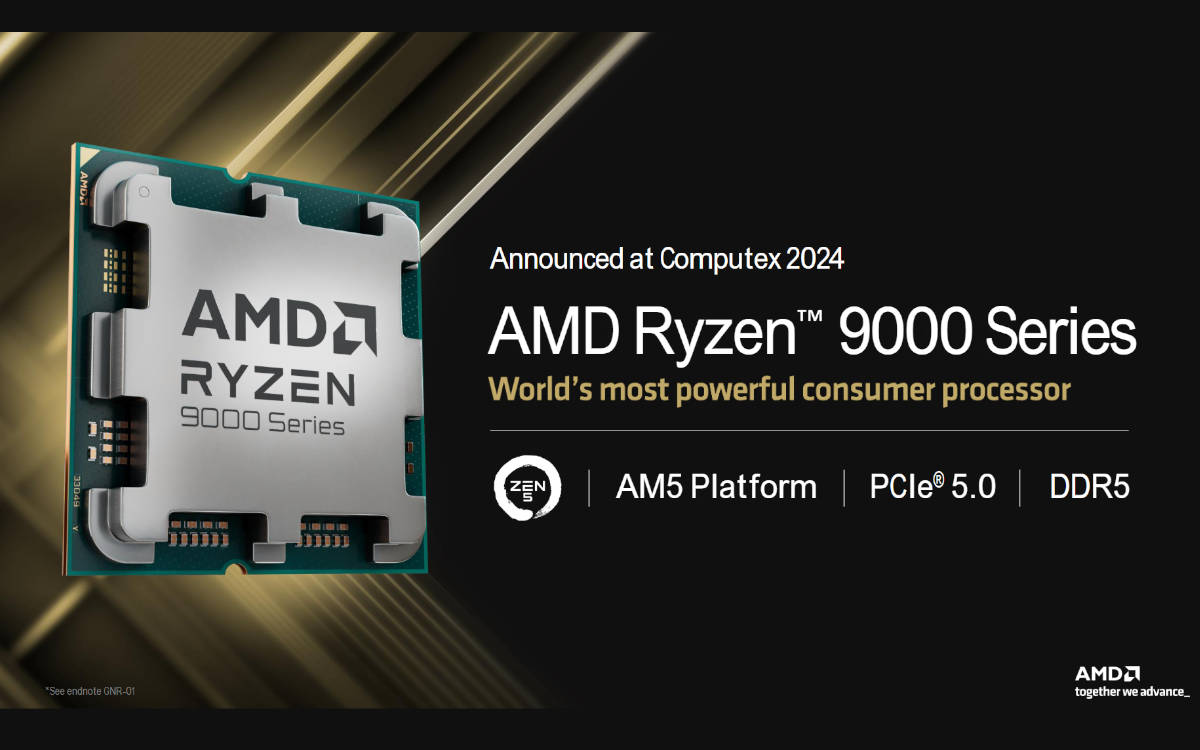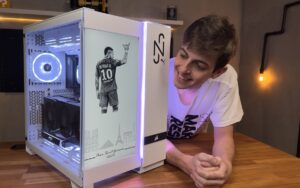
AMD has detailed the news about its future processors based on the Zen 5 microarchitecture. In addition to the AMD EPYC line, focused on servers, the company spoke about its desktop processors, the Ryzen 9000, codenamed Granite Ridge, and its models for notebooks, the Ryzen AI 300, codenamed Strix Point.
In this article, we will detail the main developments in these products, both in their Zen 5 processing cores, new technologies introduced and also the update in the AM5 platform mainboard line, the AMD chipset 800.

In another article we will focus on Strix Point notebook processors, talking about their technologies such as heterogeneous cores, integrated RDNA 3.5 graphics and AI acceleration via XNDA 2.
Zen 5
The new generation of processors is based on the Zen 5 microarchitecture. AMD has sought new double-digit percentage gains compared to what is offered in Zen 4 processors (Ryzen 7000 and 8000G). According to AMD, the average performance gain compared to its predecessors is 16%.

One significant change is the increase in IPC. Zen 5 cores are capable of delivering more work per cycle. Part of this improvement is the increased robustness of the basic structure of Zen 5 cores compared to Zen 4 cores.



The instruction input structures have become larger, and AMD has doubled the bandwidth of level 1 and 2 cache memory (L1 and L2 cache), increased the amount from 32kib to 48kib and increased the accuracy of predictions of the data that will be needed, all to reduce the need to make cache accesses and move data.
In other words: the overall processing is accelerated, thanks to more robust hardware in both inputs and outputs of operations, and the cache system has been reinforced to ensure that bottlenecks do not occur and the system does not remain idle because it is waiting for data. As AMD itself calls it in the presentation, it is necessary to “feed the beast”.
Another relevant change is in heating. This topic was criticized in our Ryzen 7000 reviews, with the noticeable increase in temperatures in these products compared to their Ryzen 5000 predecessors.
The secret here is a more efficient use of sensor information. AMD has made the distribution of load across the chip more efficient, in order to mitigate temperature spikes at specific points on the die, hotspost. With this, we have a 7ºC reduction in temperature, operating at the same TDP as a Ryzen 7000 model.

Overall, the Zen 5 microarchitecture achieves performance gains through several simultaneous improvements. Fetch, Execution, Decode, and cache memory bandwidth all contribute more or less similarly to the advances of this generation.
AMD Ryzen 9000 (Granite Ridge)
The specific processor models did not receive any news at the event, after all, they had already been announced at Computex 2024. In general, they maintain the same configurations as their predecessors, with the Ryzen 5 line delivering 6 cores, Ryzen 7 with 8 cores and the Ryzen 9 line with 12 and 16 cores.
The new features include an improvement in cooling. As we highlighted in the introduction, Zen 5 will heat up less. In desktops, there are two important points for the evolution of this feature.
AMD Ryzen 9000: cooler
First up is a new design with better heat conductivity. Ryzen 9000 chips now dissipate heat 15% more efficiently, resulting in 7°C cooler operation at the same TDP.

But there was also a reduction in the TDPs themselves. With the exception of the Ryzen 9 9950X, which will continue with the high TDP of 170W, all Ryzen 9000 models will have reductions in heat dissipation. The Ryzen 5 and Ryzen 7, for example, return to the estimated TDP of 65W, the same as they had in the Ryzen 5000 line.
This reduction means a lower cost when purchasing cooling systems. In the Ryzen 7000 series, the recommendation was liquid cooling for all X models from the Ryzen 5 7600X onwards. Now we have a good chance of this being minimized again in the 9000 series.



To achieve this reduction in TDP, AMD changed the Ryzen operating curves to bring heat dissipation to lower levels than its predecessors.
Despite the evolution in production and heat, the Ryzen 9000 continues to feature AMD ECO mode, introduced with the Ryzen 7000, which changes the CPU operating curve to increase efficiency, reducing consumption and heating with a reduction in performance.

Ryzen 9000 processors will be available starting July 31.
Chipsets 800
There are also new features on motherboards. AMD had already announced the new top-of-the-line chipsets, the X870E and X870. At the deep dive in Zen 5 technologies, the B850 and B840 chipsets were announced.
The main differences are reductions in PCI Express slot speeds as well as slower USB technologies, as well as the change in overclocking support. The B840 continues to support memory and processor overclocking, but reduces support for PCIe 5.0 to just one NVMe slot, and PCIe 4.0 for the video card.

The B840 chipset is the most curious. It does not allow for processor overclocking, only memory. The PCIe slot is limited to supporting PCIe 3.0 technology. These restrictions make it almost look like a chipset from the “A” end 20 line of previous generations, such as an A520 or A320, despite being a “B” chipset.
Overclocking: AMD Ryzen 9000 Memory
We have new features in terms of operating frequencies and the ability to modify these settings by the user. The big news seeks to resolve a deficiency compared to rival Intel models: memory speed.
Up until the Ryzen 7000, the memory communication structure and the Infinity Fabric that connects the various structures of Ryzen chips had a limitation. You achieve the best results by going up to 6000 million transfers per second (MTs, or 6000MHz, as it is commonly called). Above 6400MHz, not only does it start to become more difficult to stabilize the system, we also start to see less relevant gains and even drops in performance.

The new AGESA will handle RAM speeds in the range of 8000MTs, improving not only stability, but also getting more performance gains from this configuration. AMD will also expand official support, also supporting the JEDEC standard at speeds of 5600MTs, “leveling the game” with Intel, which has supported this speed since the 13th generation Intel Core.
While the operating ratio of Infinity Fabric and memories had its “sweet spot” at around 6000 to 6400MTs operating at a 1:1 ratio (3000MHz in DDR, 3000MHz in Infinity Fabric, for example), now memories operating at around 8000MTs should deliver another performance gain, compensating for the additional latency of switching to a 2:1 ratio with much faster memory operation.
An interesting new feature for memory overclocking is the ability to make adjustments while the operating system is running, Memory Overclock On-the-Fly (OTF), through Ryzen Master. If the system becomes unstable and reboots, you will return to a stable DDR profile and can try again, with another adjustment. Unfortunately, the new features for memory were restricted to the Ryzen 9000 models.
Overclock: Processadores AMD Ryzen 9000
For processor overclocking, we also have new features in Zen 5-based Ryzens. Previous generations already had the Curve Optimizer available. With it, you can create an upward or downward deviation in the processor’s operation.
The problem with this approach is that this adjustment is not efficient across the entire processor operating curve. For example, an undervolt may work when the processor is running at high frequencies in a single-core cycle, but it may be insufficient to sustain a slightly lower clock speed but with all cores working simultaneously.
To solve this, the Ryzen 9000 brings a new setting, the Curve Shaper. It allows you to make the necessary micro-adjustments for the offset to work in different scenarios. This way, you can configure different changes in high or low frequencies, lower or higher temperatures.

Speaking of overclocking, the extreme overclocking session with LN2 was a good time to understand the performance leap of the Zen 5 models versus their predecessors. The record in CineBENCH multithreaded is 50843 achieved on a Ryzen 9 7950X operating with all its cores and 6.7GHz. The Ryzen 9 9950X operating at 5.9GHz was already able to reach 51340, after all the new technology can perform more processing per cycle, so it can deliver a higher score even at lower clocks.
This concludes our summary of Ryzen 9000 processors. We will still cover more Zen 5 CPUs in another article focused on Strix Point, which make up the notebook models, with the Ryzen AI 300 series products.
Source: https://www.adrenaline.com.br/amd/amd-ryzen-9000-detalhados-zen-5-com-mais-ipc-novos-recursos-de-overclock-e-mais-frios/


